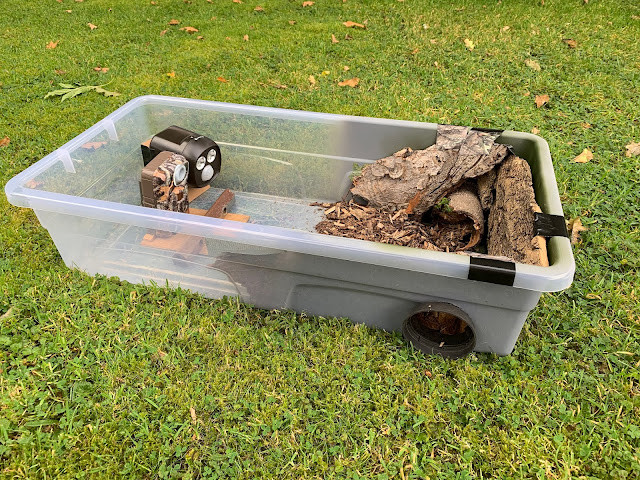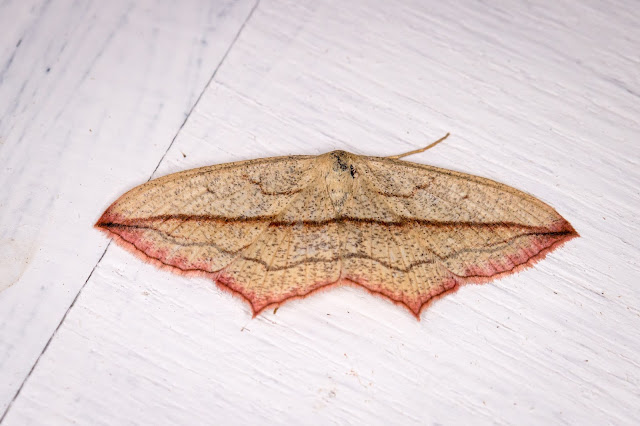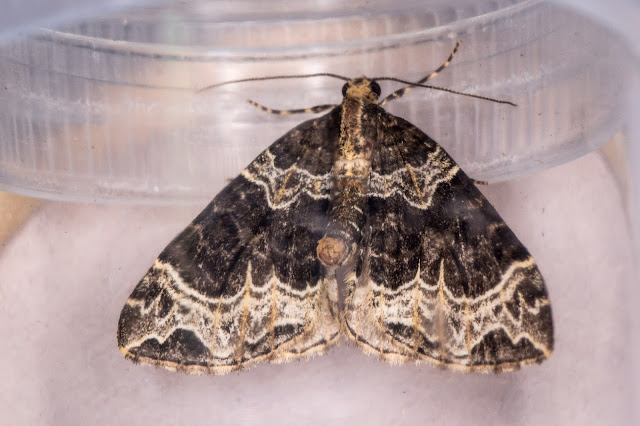Ever since the weasel turned up in the garden in the summer I have been trying to get another picture. Inspired by the Mostela*, a trail camera box used for monitoring stoat and weasel populations, I built one similar from a translucent plastic storage box (£7 from Dunelm). There are two holes at one end and a trail camera at the other. The Mostela was designed by Jeroen Mos, an ecologist and small mustelid researcher in The Netherlands, and is an enclosed box with a cutaway plastic pipe connecting the two entrance holes. Wanting better pictures in a more natural setting, I made mine to admit natural light and built a small "stage set" of bark and loose bark chippings at one end. The trail camera has a +2 dioptre lens to cope with the close focus. It can record in colour in daylight but reverts to infrared when the light is poor or at night and it is then augmented by a motion-activated battery-powered infrared security light (a Brlnno APL200). This is a view of the box with the lid removed.
My Blog List
Sunday, 31 October 2021
Pop goes the weasel
Ever since the weasel turned up in the garden in the summer I have been trying to get another picture. Inspired by the Mostela*, a trail camera box used for monitoring stoat and weasel populations, I built one similar from a translucent plastic storage box (£7 from Dunelm). There are two holes at one end and a trail camera at the other. The Mostela was designed by Jeroen Mos, an ecologist and small mustelid researcher in The Netherlands, and is an enclosed box with a cutaway plastic pipe connecting the two entrance holes. Wanting better pictures in a more natural setting, I made mine to admit natural light and built a small "stage set" of bark and loose bark chippings at one end. The trail camera has a +2 dioptre lens to cope with the close focus. It can record in colour in daylight but reverts to infrared when the light is poor or at night and it is then augmented by a motion-activated battery-powered infrared security light (a Brlnno APL200). This is a view of the box with the lid removed.
Tuesday, 26 October 2021
Even more moths
Since my last post on moths in the garden I have been setting the trap every week or two and each time I find moths I haven't seen before - apart from the latest time when the only thing in the trap was a crane fly. The species count is now over 100 although there are also several mid-sized greyish-brown jobs I am not sure about. The rest of them have been spectacular so here are few of the recent beauties I can identify fairly confidently.
Blood-vein,
Canary-shouldered Thorn,
and Centre-barred Sallow.
I joined the North East Garden Moth Scheme meeting in Gosforth Nature Reserve one evening and saw these three - Herald,
Devon Carpet, apparently a first record for the county,
and Small Phoenix.
Back in my garden - Pebble Hook-tip,
Silver Y,
Mother of Pearl (a micro-moth, but rather a large one),
Copper Underwing,
Dusky Thorn,
Shuffle-shaped Dart,
Angle Shades,
Rosy Rustic,
and Red-green Carpet.
The last is the second largest moth I have seen - a Red Underwing.
That's it until next year. I look forward to next spring to see what will turn up then.
Friday, 22 October 2021
Ladybird, ladybird, fly away home
The weather here has been odd in October, down to 1℃ on one night recently but up to 20℃ on a few days. One one warm day last week there was a cloud of ladybirds on the south-facing wall of the warden's lodge at the nature reserve. They were all harlequin ladybirds (Harmonia axyridis) and my friend Phil J counted them - 670 - although I think he may have missed one! We saw several different colour forms.
When I got home I found about 50 on the wall of my house.
Then this week I found them on the ivy in the copse at the north end of the garden.
Alongside the adults I found several fifth stage instars (larvae),
and pupae.
One of the reasons Harmonia axyridis is so successful is that it can breed so late in the season. The larvae have to pupate and the pupae emerge as adults before hibernating this winter. Breeding is long since finished for the native species.
Harmonia axyridis is a non-native invasive species that was introduced from Asia to Europe to control aphids and has since spread to the UK. It arrived in 2003 and spread rapidly across the country, reaching the North East in 2010. It and its larvae eat aphids but will eat all sorts of other insect larvae as well, including those of our native ladybirds. Large aggregations form on warm days at this time of year, looking for a place to hibernate.
Harlequin ladybirds come in many colour forms, even though they are all the same species. The three commonest forms are f. succinea, yellow, orange or red with 0-21 black spots,
f. spectablilis, black with four orange or red markings,
and f. conspicua, black with two orange or red markings.
Ladybird, ladybird, fly away home
Your house is on fire, your children are gone,
All except one and her name is Ann,
And she hid under the frying pan.
The meaning of this nursery rhyme is unknown. For discussion of the possibilities see Wikipedia.
Sunday, 17 October 2021
Fox News
The foxes still visit the garden every night. The photo below shows four, the alpha vixen at the back and three cubs of varying size but recently I have only seen two or three foxes together.
A few weeks ago the food was all gone within an hour. Now there is sometimes food left when I go to bed, although it is all eaten before dawn. They still manage to eat one litre of peanuts every night - that is 600g, or about 1000 peanuts, so shared between six or seven foxes they each eat around 150 peanuts.
I don't think I'll see large family groups any more this year but I'll keep an eye out to see who's about and what they are up to.





















































